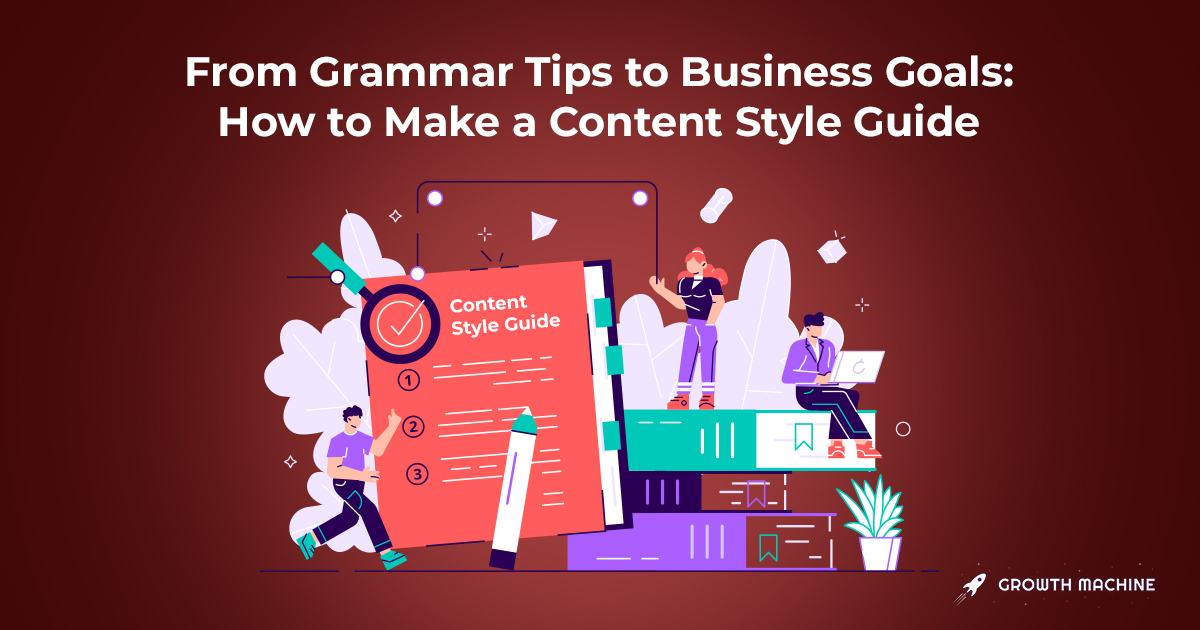From Grammar Tips to Business Goals: How to Make a Content Style Guide
Is it WiFi or Wi-Fi? Is the first letter in every word of the headline capitalized? And what’s the guidance on linking out to external sources?
When you’re running a content operation, questions like these come up often. But they come up even more often at Growth Machine, where we work with dozens of clients and publish more than 100 articles per month.
We don’t want to hold up the content creation process by asking repeat questions about client writing style preferences, so we hire expert writers and work to make our client production cycle as efficient as possible.
The best way to address these questions at scale? A style guide.
A style guide isn’t just a tool for designers to stay on brand. Think of it as a training resource for you and your writing team to ensure you’re sticking to SEO best practices and company goals. An effective style guide will properly communicate:
- A standardized way to organize your ideas and reference internal and external content
- Guidance on your voice and tone so your team can write in a consistent style
- …all laddering up into how your content upholds your business goals.
Our style guide lives in Notion, our workspace for company documentation, but we repurposed it so you can make a copy of it as your starting point (at the bottom of this post!). But first, read on to learn more about what your guide needs to set up your writers — and ultimately, your business — for success.
Define best practices for SEO and blog post structure
A good writer doesn’t need to be an SEO expert. But it helps to arm your writing team with the most important knowledge, such as how to use subheaders and key terms, what constitutes a high-authority link or external resource, and how to structure writing for optimal readability. This will ensure they write with some SEO intent and save you editing time as you get close to publication date. Here are some of our SEO best practices from our style guide:
Headlines and subheadlines:
Headlines and subheadlines help structure your content and are extremely important for determining your article’s Google ranking. When we submit articles to clients, we like to provide three title or headline options, all within AP Style (but more on AP style later). Each option is around 50 characters and includes the key term.
Below the blog post title and introduction are subheadlines using H2 headers. Any subsections should have H3 headers, and sub-subsections should have H4s.

Key terms:
If you don’t choose good keywords to inform your overall content strategy, it won’t matter how good your content is. And once you have those key terms, make sure you’re using them optimally and consistently throughout your content.
Be sure to include the full key term in your titles and in at least one H2. The key term needs to appear a few times throughout your article, especially in a way that sounds natural. Make sure you avoid keyword stuffing by not including the key terms too many times.
Internal and external links
The goal with everything you write should be to produce the very best piece of content on that topic. So aside from making sure your content is engaging and that the topic is relevant, the information also needs to be high quality.
Some ways to ensure that high quality are by linking to internal and external sources. Our rule of thumb is to use at least three internal links and at least one high-authority external link. Internal links help to keep readers engaged on your site and help direct organic traffic to other key pages, and increase your overall site authority.
But what constitutes a high-authority external link? Generally, high-authority sources are popular or household names in the field, major news sites, scholarly sources like scientific journals, and .gov, .org, or .edu sources.
For cooking content, food and recipe websites like Bon Appetit and Epicurious are good links. For wedding content, long-time frontrunners like The Knot and Brides.com are also good options.
Aside from guidance on which links to use, offer guidance on which links to avoid (if any), and how to incorporate that link into the blog post.

Image use
This isn’t just about finding an image that’s on-brand for your company. For SEO purposes, it’s good to have a standard for specs and metadata so that you can ensure consistency and a great reader experience. For instance, we recommend at least three images per article or a minimum of one image per 500 words — whichever is more. Other specs to include are optimal image orientation and file size, which may vary depending on the layout of your site.
You should also be sure you have a standard for alt text, which is a description of your image in case that image fails to load on the website. Alt text is one piece in the puzzle that signals to search engines what the page is about.
Your readers won’t see alt text unless they’re using a screen reader, but Google will. In fact, they have a reference page with granular guidance on this, cautioning against keyword stuffing and advising that you write brief but information-rich descriptions of your images.
Paragraph density and readability
SEO best practices tend to center on what makes for the best user experience which in turn inform search engines’ algorithms. The last things to consider in overall blog post structure are paragraph density and readability.
Offer your writers guidance on introductory paragraphs in your style guide. While there’s no hard and fast rule that an intro needs to be three paragraphs, we tend to recommend at least two paragraphs. This should give the writer enough space to make their case for why the reader should care about the topic or thesis and why the reader should care that your site is the one saying it. Then, throughout your blog post, try to keep paragraphs under six lines of text. This makes the content more skimmable and readable.
Aside from paragraph density, consider how using active (vs. passive) voice and writing for certain reading levels can make your blog posts easier to digest. Active sentences are often shorter than passive sentences and easier to understand. Further, about two-thirds of Americans read at a fourth-grade to eighth-grade level. So it’s worth considering writing your content at a similar level.
Fortunately, there are lots of online writing tools that instantly assess grammar and readability. Here are some of our favorites:
- Hemingway: This tool highlights complex sentences and passive voice, offers simpler words or alternative phrases, and flags sentences that are hard to read.
- Readable: They offer a nice Test Your Readability tool to quickly assess your copy. It’ll flag how many spelling or grammar errors you have, along with a Flesch-Kincaid Grade Level that estimates the school level that best matches your copy.
- Grammarly: We love using Grammarly not just to double check any grammatical errors, but also to run plagiarism checks. That way, you can catch if a writer cut corners by copying and pasting from other published content.
Nip common mistakes in the bud with grammar guidance
If your marketing team has a strong stance on how to use the Oxford comma (we are decidedly pro), be sure to include that in your style guide. If you have a specific style for how certain words are spelled (WiFi vs. Wi-Fi, for instance), include that too. Our editors are trained in AP Style, so we used that to shape our style guide, but you can use Chicago Style if you are more familiar with it.
Don’t know a thing about either one? Most content writers and any trained journalists are familiar with AP, so it’s a smart baseline. Here’s a cheat sheet to AP Style that you can include in your style guide. Without an industry-standard stylebook to ground you, each post will be a lawless land where semicolons run free and formatting is wildly inconsistent.
In addition to that, save yourself an editing headache by including a list of commonly used terms for your business, like the stylization of your company name and product names. Here’s an example from our real-life style guide for a client that frequently discusses the rideshare industry:

We gathered these specific rules in two ways:
- We looked up everyday terms (“rideshare,” “rearview mirror”) in the AP Stylebook and copied their formatting.
- We looked at the Lyft and Instacart websites and copied their spacing and capitalization for their terms.
You can do the same for any topic or industry you work in. If you don’t want to purchase online access to your stylebook of choice, simply Google “AP Style [word].”
Be specific about your unique style principles
There are some general best practices that apply to any company, such as ensuring you always write an interesting, attention-getting introduction. But perhaps you always want to conclude your articles with a specific call to action. Or perhaps your company has a strong stance on never mentioning a competitor. It might make sense to link to your brand style guide, which may already specify core values that you want to shine through in your writing.
Whatever the case, be upfront about the voice and tone in which you want your writers to communicate, and any style principles they should follow.
Consider laying out do’s and don’ts in a table format to more clearly state your preferences or quirks, like we did here:

Explain how your content ties to your business goals
Think of this section as your guiding light for the overall editorial vision. An effective style guide provides tactical, black-and-white guidance on content creation as well as a reminder of the dotted lines that connect your content strategy with your marketing and sales goals and, ultimately, your business goals.
Consider a section that answers the below three key questions:
Who is your target audience?
Reminding your writers of who they should write for will help them keep in mind how familiar the target audience is with the topics at hand as well as what assumptions may be fair to make.
For instance, if you’re writing a post about the ketogenic diet for nutrition and fitness enthusiasts, it’s probably safe to assume that you can say “keto” instead of “ketogenic” in every instance.
How well does your current audience know your business?
In most cases, it’s fair to assume your audience knows little about your business. If you’re writing content about an emerging business within a well-known brand, that detail should inform how your writers present ideas. And if you’re not (yet!) a well-known brand, you can specify certain details about your company that you’ll want your writers to include.
For instance, if you’re reading this blog post, you’re probably aware the Growth Machine is a marketing agency. But you might not know that the bread and butter of our business are content creation and SEO.
What business need does each piece of content fulfill?
For each blog post you publish, think about the marketing, sales, or business need it meets. Is it product awareness? A case study? News about the company? When you define the business need, you’ll be able to tie the content to a relevant call to action. A product awareness-oriented post can point to a product page or even a Typeform survey where readers can offer feedback. A case study can link to your Contact Us page, and a news announcement can link out to a PR Contact form.
Steal our style guide
And if you want even more G Suite templates to power your content efforts, check out our favorite Google Sheets templates.






